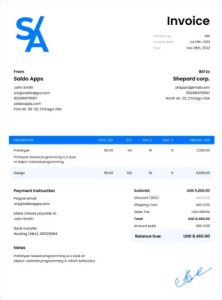
How to Apply a Discount to an Invoice
How to Apply a Discount to an Invoice A good discount is what your customer…


This method is convenient for businesses and orderers since it’s as transparent and predictable as possible. Both parties know the amount of compensation that will be provided. However, the format may not be suitable for complex and large-scale projects in which it’s difficult to predict all the nuances.As a business owner, you run the risk of cutting your pay and working overtime or, conversely, asking too much and scaring off a client. With this approach, you should clearly identify all the upcoming tasks and know how to calculate a flat-rate pay to receive appropriate compensation.
The second payment scheme is called an hourly rate. What is an hourly rate? In this case, the name speaks for itself. Under this method, compensation depends on how much time you spend on a task. As a rule, it’s used for large and complex projects, where it’s pretty difficult to consider all the work and possible force majeure. You can only roughly estimate the scale of tasks, but the calculation is made after job completion.
When you negotiate a billing system with a customer, both parties need to understand that the final amount at the finish line will change. You, as a performer, can benefit because you remain flexible, can adapt to changes, and know that you’ll be paid appropriately for overtime. Along with it, some businesses prefer to forego the hourly rate as they don’t know at the start how much money they’ll spend on a project.
The difficulty with the scheme lies in the calculations and the billing process. If you wonder, “What hourly rate should I charge?” you need to study the standard rates in the industry and region. You don’t want to put too high a price so that a client doesn’t go to a cheaper contractor, and at the same time, you don’t want to deprive yourself. For example, to get the minimum allowable payment, you can define your labor costs, add overhead costs, and the profit you would like to receive from the execution of this order to them. The amount received should be divided by the planned number of hours. Depending on the situation in a region, you can raise this rate.The difficulty in using the hourly rate system lies in understanding how to write an invoice for hours worked. When completing projects with this form of payment, you need a reliable timer with which you can mark the start and end times of work. This information should be transferred to the invoice for hours worked template.
Of course, within the same project, you may have tasks with different rates due to their complexity, so each should have its own line in your bill. And each should be timed separately. To get the total sum payable, you multiply the hours spent by the rate and then add each item on your list, taking into account the materials used and the due fees.
Comparing different approaches to pay for your work, for example, salary vs. billable rate, consider the specifics of your work and be guided by the standards of the industry and your region. Whichever method you choose, SaldoInvoice will provide you with all the tools you need for invoicing and getting paid on time.
When you’re paid by the hour, the clock becomes your best friend. Getting paid by the hour can be awesome when your projects are like a box of chocolates—you never know what you’ll get. In such situations, flexibility is your ally, allowing you to roll with the changes and get paid for all the time you put in.
But then again, it’s like watching a movie with a plot twist; you’re left guessing how much you’ll rake in until the very end. Clients might be uneasy, fearing that their bills will skyrocket. Also, let’s be real, an hourly rate turns budgeting into a bit of a head-scratcher for you and your clients.
Here’s the thing: Choosing between flat rate pricing and hourly rate pricing is not as simple as flipping a coin. It’s more like a recipe where multiple ingredients or pricing considerations affect the final dish. Here are some of those ingredients:
So, you know what you’re good at, but how do you translate that into dollars and cents? So, the goal here is to make sure your service charges actually match up with what you’re bringing to the table. Take a beat and really think about what you’re offering, you know? What’s your special sauce? What sets you apart from the crowd?
Scope out what your competition is up to; do a rate comparison to see how your rates stack up. And don’t forget to listen to your target market. They’ll let you know what they will pay for your skills.
Regarding client billing, consider it a two-way street where building a lasting relationship is paramount. It all starts with a straight-up chat about your billing methods and how you will charge and bill them. Transparency is the golden rule here. Lay out your payment structure, what your client can expect, and what each cost covers. Being super clear and upfront about everything will make your clients dig what you’re all about and keep them coming back for more.
Finally, when you’re choosing between flat rate and hourly pricing models, there’s no magic pricing strategy that will work every time. Knowing what you’re talking about and being crystal clear about your fees is like laying down the welcome mat for a really solid business relationship.

How to Apply a Discount to an Invoice A good discount is what your customer…

How to Add Taxable and Non-Taxable Items on One Invoice Invoicing is never as straightforward…

3 Reasons to Use Paperless Invoices It is 2024 out there, and machines have already…